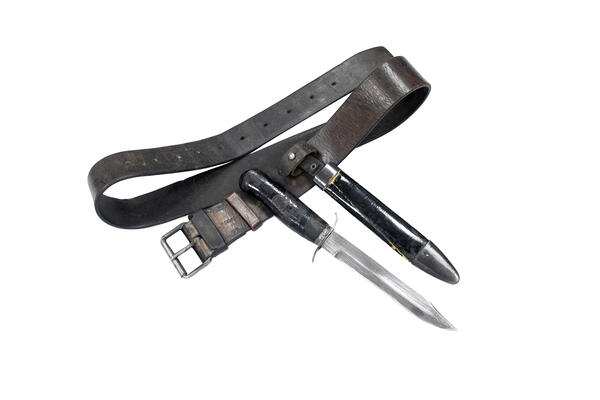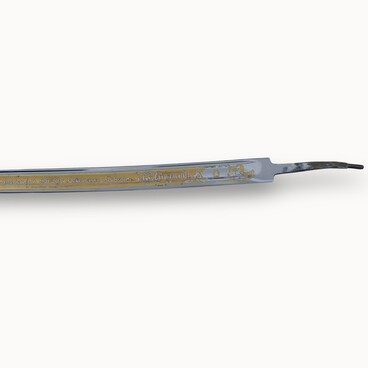The army knife of the 1941 model is a legendary weapon of Red Army tankmen. It was also used by scouts, paratroopers, and submachine gunners. It received the name “black knife” due to the varnish coating of the surface of its wooden scabbard and black handle.
The Zlatoust Plant named after Vladimir Lenin manufactured the knife from 1942 to 1955. In the technical documentation, the weapon was listed as “type N-41”, and in the report of the head of workshop No. 16 it was classified as a “dagger knife”.
In total, throughout the war years, the plant produced over 906,000 army knives of the 1941 model. 10,000 of them were made in excess of the output plan to be given to the soldiers of the Ural Volunteer Tank Corps formed in 1943.
The corps was staffed by privates and non-commissioned officers from among the volunteers of three regions of the Urals: Molotov (currently Perm Krai), Sverdlovsk and Chelyabinsk. Almost all weapons, military machinery, equipment, and uniforms for the volunteer tank corps were manufactured by the country’s enterprises in excess of the plan, with money raised by workers of the Urals.
The black-handled army knives instilled fear and respect in the enemies. For the Ural volunteers, the “black knife” became a symbol of their glorious military unit. The blade of the army knife of the 1941 model had a straight shape. It was a single-edged weapon, with no fuller cut therein.
The wooden handle was designed for a hidden-tang (rather than laid-on) attachment, which simplified and reduced the cost of manufacture. In addition, a flat iron guard was created, which had its ends bent in opposite directions (with the so-called S-bend). This feature made the army knife a weapon of choice for close-in fighting.
The steel parts of the knife fixtures were blued; they were obtained as a result of blackening — the process of deposition of a layer of iron oxides on the surface of the steel. For the convenience of attaching the knife to the belt, a special leather strap suspension was made, with a fastener to keep the knife within the scabbard.
The Zlatoust Plant named after Vladimir Lenin manufactured the knife from 1942 to 1955. In the technical documentation, the weapon was listed as “type N-41”, and in the report of the head of workshop No. 16 it was classified as a “dagger knife”.
In total, throughout the war years, the plant produced over 906,000 army knives of the 1941 model. 10,000 of them were made in excess of the output plan to be given to the soldiers of the Ural Volunteer Tank Corps formed in 1943.
The corps was staffed by privates and non-commissioned officers from among the volunteers of three regions of the Urals: Molotov (currently Perm Krai), Sverdlovsk and Chelyabinsk. Almost all weapons, military machinery, equipment, and uniforms for the volunteer tank corps were manufactured by the country’s enterprises in excess of the plan, with money raised by workers of the Urals.
The black-handled army knives instilled fear and respect in the enemies. For the Ural volunteers, the “black knife” became a symbol of their glorious military unit. The blade of the army knife of the 1941 model had a straight shape. It was a single-edged weapon, with no fuller cut therein.
The wooden handle was designed for a hidden-tang (rather than laid-on) attachment, which simplified and reduced the cost of manufacture. In addition, a flat iron guard was created, which had its ends bent in opposite directions (with the so-called S-bend). This feature made the army knife a weapon of choice for close-in fighting.
The steel parts of the knife fixtures were blued; they were obtained as a result of blackening — the process of deposition of a layer of iron oxides on the surface of the steel. For the convenience of attaching the knife to the belt, a special leather strap suspension was made, with a fastener to keep the knife within the scabbard.




